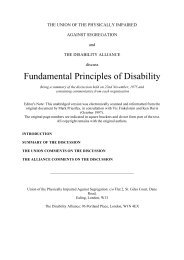Global-Report-Living-Colour-dr2-2
Global-Report-Living-Colour-dr2-2
Global-Report-Living-Colour-dr2-2
You also want an ePaper? Increase the reach of your titles
YUMPU automatically turns print PDFs into web optimized ePapers that Google loves.
102<br />
Inclusive Communities = Stronger Communities<br />
GLOBAL REPORT ON ARTICLE 19: THE RIGHT TO LIVE AND BE INCLUDED IN THE COMMUNITY<br />
Table 5: Where and With Whom: Issues and Future Direction<br />
Issue<br />
Families are the only source<br />
of support<br />
State sponsored residential<br />
options are segregated and<br />
institutional<br />
Daily living supports are<br />
attached to real estate<br />
Limited Vision of Options<br />
Safety and Violence<br />
Future Direction<br />
Investment in formal (state sponsored) and informal<br />
(friends, neighbors and community) supports for day to day<br />
living that are individualized and flexible<br />
Shift the focus of investments from group homes and<br />
“institutionally” operated housing to more individualized<br />
living arrangements which might include support to live at<br />
home with the family<br />
Disentangle other supports from the provision of housing<br />
Build and support family based organizations and selfadvocacy<br />
groups to enable sharing of experience and<br />
examples across communities, countries and internationally<br />
Educate people with disabilities about their rights<br />
Ensure access to justice by people with disabilities (Article<br />
13 of the CRPD)<br />
Support<br />
Services and supports for people with intellectual<br />
disabilities and their families will vary with a country’s<br />
culture, history and tradition. There is no one “model” or<br />
way of doing things, however we do know from a half<br />
century of research and practice that institutional care is a<br />
model that does not and cannot work. The CRPD and<br />
especially Article 19, calls for people with intellectual<br />
disabilities and families to have the same access to services<br />
and the community as others in their society. It does not<br />
call for all services and supports to be of one type, or to all<br />
look alike. In the developed world challenges remain,



